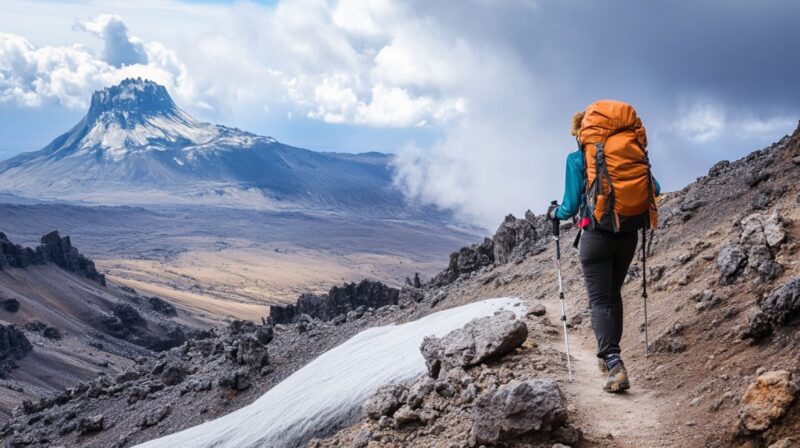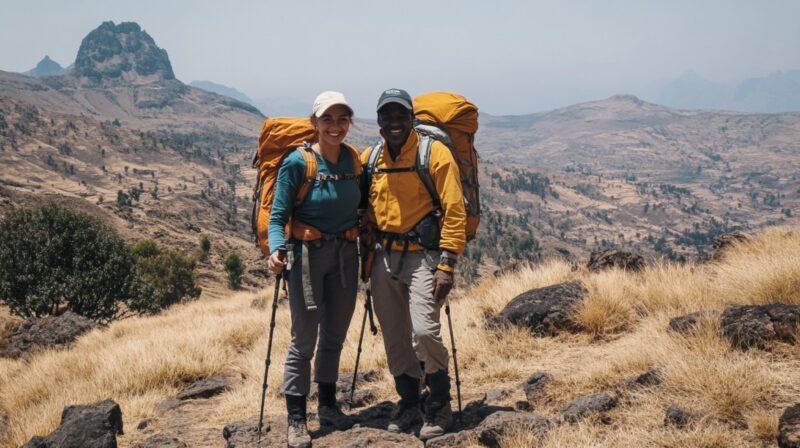High-altitude hiking in Ethiopia offers some of the most dramatic and physically demanding experiences in East Africa.
With elevations soaring over 4,000 meters in regions like the Simien Mountains and Bale Mountains, hikers are met with both awe-inspiring terrain and serious physical challenges.
Low oxygen levels, rugged ascents, and unpredictable weather can test even the most seasoned trekkers.
Preparing thoroughly for these hikes is essential, not just for enjoyment but for safety.
Physical Preparation
Climbing through Ethiopia’s high-altitude regions is not just about lacing up boots and heading out. Altitude changes every step of the game.
Lower oxygen levels put more pressure on the body, so proper conditioning well before arrival is essential.
- Cardiovascular endurance
- Muscular strength
- Exposure to simulated altitude environments
Each component plays a role in helping the body perform efficiently while reducing the risk of altitude sickness or fatigue.

Cardiovascular Conditioning
Thinner air reduces oxygen availability, making the heart and lungs work harder. Conditioning the cardiovascular system improves oxygen delivery to muscles and boosts endurance during long ascents.
Activities like running, cycling, and swimming, especially with intervals, train the body to handle exertion with less oxygen.
Training hikes on nearby hills offer real-world simulation of trail climbing. Weekly hikes that gradually increase in elevation and length prepare both mind and body for longer days at altitude.
- Run 3–4 times per week, focusing on trail or hill intervals
- Cycle on hilly terrain or use a stationary bike with resistance
- Swim with structured breath-hold or limited breathing sets
- Include weekly hikes that add 100–200 meters of elevation gain each week
Strength and Endurance Training
Tough terrain and steep climbs call for strong legs, hips, and core muscles. Building functional strength reduces strain on joints, helps maintain balance, and delays fatigue.
Bodyweight movements like squats and lunges create a solid base, while core exercises improve posture and support during long hikes.
Backpack training is especially important. Carrying weight helps condition muscles under load and gives insight into what feels comfortable or too heavy.
- Bodyweight exercises: squats, lunges, step-ups, and planks
- Core work: Russian twists, hanging leg raises, and mountain climbers
- Backpack training: start with 5–7 kg, increasing to 12–15 kg over time
Stair climbs or hill repeats with a weighted pack for combined strength and cardio
Altitude Simulation (if possible)
Attitude affects individuals differently. Simulating conditions before travel gives the body a head start. Hypoxic training masks and altitude tents reduce oxygen levels to mimic mountain conditions. These tools can be worn during cardio sessions or used during sleep.
For those without access to gear, high-elevation training hikes close to home offer a practical option. Even weekend hikes at moderate elevations can help prepare the lungs and muscles for lower oxygen levels.
Simulated or real, any exposure can reduce shock when stepping into Ethiopia’s higher zones.
- Use an altitude mask during treadmill or bike sessions 2–3 times per week
- Sleep in a hypoxic tent if available
- Take weekend trips to nearby mountain areas above 2,000 meters
- Practice breath control with slow exhalations during exercise to build oxygen efficiency
Mental and Emotional Preparation

Mental resilience often makes the difference between a successful hike and a dangerous retreat.
High-altitude hiking in Ethiopia challenges more than just muscles, it presses on mental stability. Thin air reduces oxygen flow to the brain, leading to confusion, irritability, and emotional fatigue. Long days, cold nights, and physical exhaustion amplify any stress already present.
Preparing emotionally starts long before stepping onto the trail. Developing a mindset that expects discomfort, accepts change, and remains flexible is essential. Accepting that symptoms like headaches, nausea, or dizziness may appear helps reduce panic when they do.
Practicing breath control, such as yogic breathing, enhances oxygen flow and calms nerves during exertion.
Daily routines that train emotional discipline also support mental strength. Visualization of each day’s hike, weather changes, or unexpected delays builds readiness. Talking through worries with a high-altitude hiking partner before the trip also helps normalize fear and build trust.
During the trek, clear and honest communication can prevent minor issues from escalating into dangerous situations.
- Practice controlled breathing (e.g., box breathing or alternate nostril techniques)
- Visualize successful completion of hikes and camps
- Role-play difficult scenarios to prepare emotionally
- Build team dynamics before departure to ensure open communication
- Establish daily check-ins to evaluate emotional and physical states
- Use music, journaling, or meditation to decompress during downtime
Positivity should be an intentional part of your daily effort. Encouraging others, celebrating small wins, and keeping humor alive on tough days strengthen the group and help everyone push through.
Acclimatization Strategies
Climbing too fast invites altitude sickness, fatigue, and potential evacuation. High-altitude hiking adaptation requires a strategy rooted in patience and awareness. Acclimatization is a biological process that cannot be rushed, no matter the hiker’s experience or fitness level.
One key method for safer altitude gain is the “climb high, sleep low” approach. Ascend to higher points during the day, then return to lower elevations to sleep. This process gives the body time to adjust without overwhelming it.
Progress should remain gradual, with sleeping elevations increasing no more than 500–700 meters per day. Elevation gain should be closely tracked, especially above 3,000 meters.
Planned rest days give the body time to stabilize. On these days, light activity continues but without elevation gain. Eating high-calorie meals, staying hydrated, and monitoring symptoms all aid in safe acclimatization.
- Limit elevation gain to 500–700m per day (in sleeping altitude)
- Schedule a rest day every 3–4 days or after major elevation milestones
- Stay hydrated (3–4 liters daily) and avoid alcohol
- Eat carb-heavy meals to fuel movement and aid oxygen transport
- Sleep in lower elevations after high climbs when possible
- Monitor signs of acute mountain sickness (AMS): headache, nausea, fatigue
- Inform your team if symptoms intensify—never ignore them
Elevation gain is not a race. Listening to your body and adjusting your itinerary as needed ensures safety and increases your chances of reaching every goal along the route.
Gear Essentials for Ethiopia’s Highlands
Ethiopia’s highlands present a mix of climates in a single day. Morning heat can shift to chilling wind, then to pounding rain before nightfall.
Proper gear reduces discomfort, prevents injury, and allows for quick adaptation to changing conditions.

- Insulation
- Protection
- Mobility
Layering allows fast regulation of body temperature as you ascend or stop to rest. Sun exposure increases with altitude, so UV protection becomes non-negotiable. Trails can be muddy, rocky, or slippery, demanding high-traction footwear and solid ankle support.
Water sources may be present but are not always safe, making purification equipment essential.
- Clothing Layers: thermal base layers, fleece mid-layers, waterproof shell
- Footwear: high-traction boots, gaiters, extra socks, and sandals for camp
- Accessories: gloves, insulating hat, buff or neck gaiter
- Sun Protection: UV-rated sunglasses, high-SPF sunscreen, lip balm
- Rain and Wind Defense: waterproof jacket and pants, pack cover
- Hydration and Safety: water purification tablets or filter, hydration bladder or bottles
- Lighting: headlamp with spare batteries
- Other Essentials: trekking poles, blister care, map and compass or GPS
Each item serves a purpose and earns its place through necessity, not luxury. Every gram carried should provide function. Regular gear checks before and during the hike prevent unpleasant surprises.
Final Checklist and Travel Planning
One week before departure, conduct a full physical and gear check. Boots should be broken in, packs should feel balanced, and essential gear should be packed for high-altitude hiking.
Confirm required vaccinations and review travel insurance policies for evacuation coverage and altitude-related incidents.
In the final days, prioritize rest and light movement instead of intense workouts. Review emergency procedures, route maps, and weather forecasts.
Enter the trip with a calm mindset, steady breath, and trust in your preparation.
